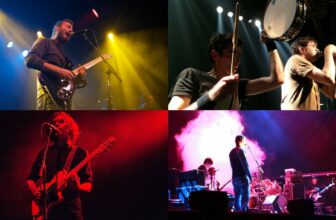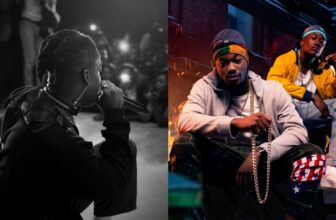10 Types Of Alternative Music

Alternative music refers to a variety of experimental rock music forms that deviate from conventional rock music. Alternative bands are distinguished more by their style than by their genre.
Most commonly, alternative music is performed by bands and artists that are outside the musical mainstream. With that in mind, alternative music is also considered more original, creative, or challenging than most mainstream and popular music genres.
Even though alternative music is becoming more popular each day, it still doesn’t get played that much on mainstream radio stations, and major record labels seldom sign artists and bands playing alternative.
There are countless “types” of alternative music, such as post-rock, indie rock, grunge, shoegaze, experimental rock, etc.
Contents
1. Alternative Rock
Of all the types of alternative music, alternative rock is one of the most popular, and most likely, you know quite a lot of bands that fall into the alternative rock category.
The term Alternative Rock, being around since the 1980s, gained a lot of popularity in the mid-1990s. Alternative rock has quite a lot of bands and artists that gained a lot of fame and recognition, such as The Cure and R.E.M.
Although it’s considered rock music, alternative rock has a lot of influence from other genres such as jazz, electronic music, reggae, etc. That fact alone tells us that there are no straightforward rules and guidelines with which artists fall into the alternative rock category. In the early stages of alternative rock, the term was used extensively for all music descended from punk rock.
Some of the most famous artists that fall under the alternative rock umbrella are Nirvana, Radiohead, Smashing Pumpkins, Sonic Youth, and much more.
2. Indie
Indie music is a term that can get somewhat confusing. Often, it can refer to independent music artists or artists and bands that play indie rock music.
You might already know some indie rock such as Arctic Monkeys, Death Cab for Cutie, The Shins, Bloc Party, and many more. Among these, other artists made indie rock music very popular nowadays, and for that reason alone, indie music started to play quite a lot on different mainstream radio stations.
Bands from these genres often use the same instruments, and most of the time, that’s where the similarities end. Every indie artist or band has developed its unique style in this genre.
3. Goth
The first wave of goth music (sometimes referred to as goth rock) kicked off in the late 1970s when the band Bauhaus released their debut single “Bela Lugosi’s Dead” which is considered the first goth record.
Goth rock separated itself from many post-punk bands that started writing more dark music with gothic overtones, such as Joy Division, Siouxsie and the Banshees, The Cure, etc. There are also many types of goth music ranging from dark wave to goth folk and goth industrial.
Gothic music uses a lot of reverb, gloomy harmonies, and dramatic or tragic songs to create a dark atmosphere. You can also hear a lot of sustained sounds in goth rock or drones.
4. Grunge
Grunge as a movement was centralized in Washington from the 1980s onward. There were a lot of influences that started grunge bands; at the time, they were considered garage rock bands like The Kingsmen, Paul Revere and The Raiders, Them, etc.
Simplistic chords and uncontrolled distortion like the ones you hear from The Sonics and The Stooges were the beginning of grunge music.
Some pioneers in grunge music were Bam Bam, Green River, Wipers, etc. The first grunge compilation album was released in 1986 and features many grunge bands that were hugely important for the future of the grunge movement. The “Deep Six” compilation album featured Green River, Melvins, Malfunkshun, Skin Yard, and Soundgarden with their first recordings.
Some of the most popular grunge artists are Nirvana, Pearl Jam, Bush, Alice in Chains, and more. Everything was good on the grunge scene in Seattle until 1991 when Nirvana released their “Nevermind” album. It gained huge popularity, even knocking down Michael Jackson’s “Dangerous” from the top of the Billboard 200.
5. Shoegaze
Shoegaze incorporated a lot of reverberation, many layers of guitar, and ethereal, obscured vocals. One of the first bands assigned as a shoegaze band was Wire. Other popular bands are My Bloody Valentine, Slowdive, Lush, Ride, Cocteau Twins, etc.
Shoegaze started in the 1980s and 1990s and was hugely popular at the time. With some of the best shoegaze bands breaking up, the genre lost popularity in the 2000s but has recently emerged and is widely popular.
Check out the best Shoegaze songs of all time.
6. Punk
Punk rock emerged in the 1970s, with its roots being the garage rock of the 1960s. Since then, punk has evolved into many different styles and subgenres, ranging from anarcho-punk to skate park to melodic punk.
Some pioneering bands in the genre include The Sonics, The Stooges, The Kinks, MC5, and Neu.
Punk rock music sounds raw, unpolished, and unfinished. The most basic instruments consisting of distorted guitar, bass, and drums, were used by most punk bands, with many punk bands consisting of only three members. Punk songs have a relatively quick pace, and except for the odd super-fast fills, the drumbeats are mostly plain and unadorned.
7. College Rock
College rock refers to non-mainstream alternative rock music played on college radios, most commonly by students. Many radio stations in the 1970s and 1980s played a lot of different genres such as post-punk, punk-rock, new wave, synth-pop, etc.
Not necessarily a genre term, college rock features diverse bands and artists such as R.E.M, The Smiths, Pixies, Red Hot Chilli Peppers, U2, and many more.
8. New Wave
New wave is a very broad and loosely defined music genre that became popular in the 1970s. It combines elements from very different music genres, such as punk rock, pop music, funk, and reggae.
New wave music, although not very concisely defined, is characterized by the heavy use of keyboards, huge experimentations with the rhythm, and mainstream appeal. Unlike punk music, closely connected to the new wave, the new wave became very popular and was played on many radios and TV stations.
Some of the most popular new wave bands and artists are Talking Heads, The Police, Duran Duran, The Cars, Blondie, and Depeche Mode.
9. Experimental Rock (Avant-Rock)
Experimental rock, sometimes known as avant-garde rock, is a style of rock music that explores the genre’s core ingredients and pushes the boundaries of standard composition and performing.
Great examples of bands and artists from this genre are The Velvet Underground, Swans, Can, Pink Floyd, and The Mars Volta, among others.
Just from the bands above, you might notice how different experimental rock can be. It was popular since its beginnings in the 1970s and is still relatively popular now, although not as much as other types of alternative music on this list.
10. Industrial
Harsh and heavy themes and noises characterize industrial music. Critics frequently refer to it as the most aggressive fusion of electronic and rock music. Industrial music started and became popular in the 1970s.
The best examples of industrial music bands are Nine Inch Nails, Laibach, Rammstein, Ministry, and many more.
You can think of industrial music as heavy metal instruments combined with different keyboards, synthesizers, and samplers. It also incorporates very controversial lyrics, such as violence, torture, and sexual deviance.
Why is it Called Alternative Music?
The phrase “alternative music” was coined in the 1980s. It was used to describe bands that didn’t fit into the mainstream genres at the time. Alternative music became more popular in the 1990s and became its own genre. Now, alternative music is very popular and is being played on many radio and TV stations.
What is Alternative Music Characterized by?
Alternative music as a genre is hard to describe, and so are its characteristics. Most often, alternative music has layered instruments, guitar melodies, and lyrics that deal with social issues. Although true, that description does not cover the whole genre correctly as many bands and artists fall under the alternative music umbrella and don’t have those characteristics.
Who Started Alternative Music?
Alternative music was started by the American underground in the 1980s, and some of its earliest bands and artists include R.E.M, The Dream Syndicate, The Feelies, Violent Femmes, and more.
Conclusion
Even though there are many more types of alternative music, other than the ten I discussed in this article, these are the most popular and widely accepted genres considered alternative music. As a whole, alternative music is much broader than the genres, bands, and artists it consists of and will always be an ever-growing and changing genre.





